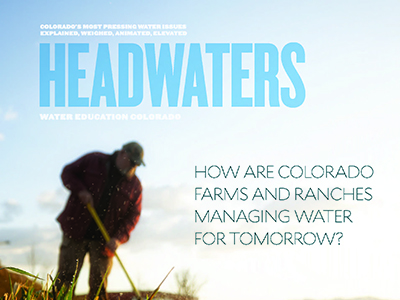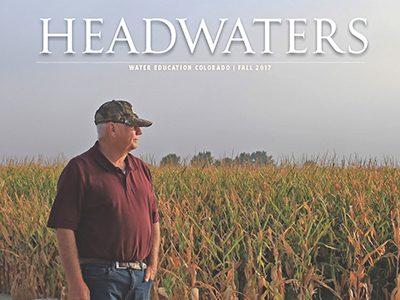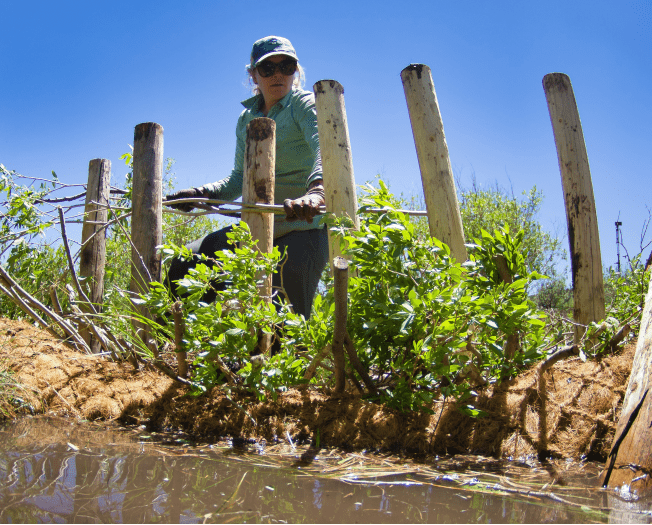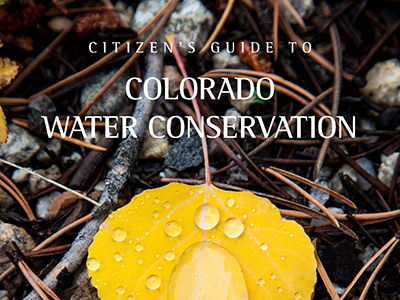Agricultural Conservation & Efficiency
Agriculture is the largest water user in Colorado and a primary economic driver in many rural counties. According to the Statewide Water Supply Initiative (SWSI) 2010, farmers and ranchers use 89% of the total water consumed in Colorado, or about 4.7 million acre-feet each year. If more water was available, producers would use it to irrigate more crops. According to the 2019 Technical Update to the Colorado Water Plan, about 80% of the overall agricultural diversion demand is currently met on a statewide basis, leaving 20% unmet. The technical update reports that agricultural water users experience the largest gap of any water use sector between available water supply and demand both currently and in 2050 planning projections. Average annual statewide agricultural gaps range from 2.4 million acre-feet to 3.9 million acre-feet. In critically dry years, however, the gap doubles in magnitude.
%
of the total amount of water consumed in Colorado is used by farmers and ranchers
The challenges of living in our arid climate, mounting municipal demands, shrinking groundwater levels, climate change, and the need to enhance environmental flows, may reduce current agricultural water supplies as those waters either voluntarily or involuntarily shift to other uses. Increasing agricultural productivity while reducing the amount of irrigated acres is an important objective for maintaining a viable agricultural, food and livestock production industry.
Both efficient water application and agricultural conservation through limited irrigation can help farmers stretch resources to survive dry years. And for those reliant on declining aquifers, agricultural water conservation and irrigation efficiency are becoming necessities. Improving the planning and infrastructure to increase efficient water use in these aquifer-dependent communities helps producers continue farming.
Conservation Versus Efficiency in Agriculture
In agriculture, water efficiency and conservation have distinctly different meanings and should be understood in terms of the scale at which their respective approaches are applied. At the basic scale of a farmer’s field or pasture, conservation is the reduction in crop consumptive use. Crop consumptive use is the amount of water permanently withdrawn from the system because it has been evaporated from the field surface, transpired by plants, and stored in the plant material. Conservation is usually accompanied by a reduced water diversion with the effect or intent of leaving water elsewhere in the delivery system for other uses.
Agricultural water efficiency is the concept of reducing water delivery and irrigation amounts without affecting the benefits water provides. This can be done by decreasing water losses at the field or farm scale, but also at larger scales within ditch, canal or basin boundaries.
Agricultural Conservation in the Colorado Water Plan
With Colorado’s semi-arid climate, a significant quantity of water is necessary to sustain irrigated crops and the agricultural economy. Under a status quo scenario, future gaps in municipal and industrial water supply will likely be met by voluntary transfers of water out of irrigated agriculture, as lucrative offers are made by urban utilities and industrial operators.
The Colorado Water Plan identifies a need to keep water on farms, which includes conservation. The plan also places high stakes on the success of alternative transfer methods (ATMs) that hinge on cooperation between agricultural, environmental and urban interests. These methods provide an alternative to permanent agricultural to urban water rights transfers, where farmers temporarily lease water to cities, typically in dry years, but continue to own it.
Beyond alternative transfer methods, agricultural water conservation will be an important element in Colorado’s future out of necessity. More dry years are expected in the future, and efficient cropping systems and irrigation methods that are adapted for drought can help reduce negative impacts on farms and rural economies.
Increased efficiency in water applications and delivery can result in irrigators diverting less water. When water isn’t diverted, the river ecosystem and downstream water users benefit. However, the farmer does not have the ability to sell or lease any portion of the water that goes unused due to an efficiency improvement because the limit of the water right is attached to the historical consumptive use of the crop itself.
Agricultural Practices for Increased Efficiency
The potential for efficiencies and means of becoming more efficient vary among operations. Efficiencies can often be found in irrigation delivery and application systems, for example by switching from flood irrigation to sprinkler or drip irrigation. The improved irrigation system ideally provides plants with just the right amount of water while reducing loss to seepage and evaporation.
Recommended best irrigation management practices can increase water use efficiency, as well as improve water quality by reducing erosion and pollution from fertilizers, pesticides and herbicides.
Best practices for managing agricultural irrigation are numerous, including improving irrigation conveyance and delivery, improving irrigation application systems, utilizing irrigation scheduling, conservation tillage, and soil health management.
Crop Selection
Finding ways to reduce the water demands of growing crops is a significant challenge to reducing water use. Under specific soil, precipitation, and other conditions, a crop’s physiology requires a certain quantity of water to grow and produce its optimal yield. For example, the consumptive use of irrigated alfalfa is between 26 and 40 inches of water per growing season depending on the location and cutting schedule, to reach optimal yield. Irrigated grain sorghum requires between 15 and 25 inches of water.
Many plants can be grown under deficit conditions, with less water than is optimal, but yields are generally lower than the maximum attainable—with yield increasing as crop water use increases. In addition to plants that are naturally well adapted to drought and deficit irrigation, seed companies like Syngenta, Monsanto and DuPont Pioneer have been working to develop drought-tolerant plant hybrids, with a focus on corn, intending to help plants tolerate drought stress and minimize the risk of crop loss in drought.
Researchers at Colorado State University found that drought-tolerant genetic modifications produced greater yields during short periods of water stress compared to non-modified varieties. However, current genetically modified varieties cannot tolerate excessive drought stress for extended time periods any better than traditional crops.
Aside from planting low-water-use crops or accepting smaller yields, a farmer can also reduce a crop’s basic water demand by reducing evaporation. Medium- and low-pressure sprinkler systems, drag lines, as well as drip irrigation systems are particularly efficient at reducing evaporation because they apply water closer to a plant’s roots.
Challenges to Efficient Water Use
Some of the biggest stumbling blocks to agricultural water conservation in Colorado are related to economics, over-appropriation of the state’s surface water supplies, and common misconceptions regarding the “use it or lose it” provisions of the state’s water rights system.
Facing strong competition, rising input costs, and commodity prices that haven’t significantly increased for years, farmers in many areas are hard pressed to afford irrigation efficiency improvements. If water prices are relatively inexpensive, this creates an additional disincentive to operate more efficiently, but when water prices are high, efficiency improvements become another burden.
In addition, almost all of Colorado’s river systems are over-appropriated — meaning the courts have approved more rights to divert water out of the stream than streamflow can satisfy during an average to below-average year. This means that when senior water right holders free up or “save” water, many junior users are waiting in line to use it.
Water rights are extremely valuable. However, under Colorado law, if a water right has not been put to beneficial use for a period of 10 years or more, the State Engineer may list the water right on the decennial abandonment list for the water court to declare that water right abandoned. Although a water right cannot be legally considered abandoned unless the owner shows intent to abandon, non-use of the right for 10 years does make it vulnerable to this sort of proceeding.
Many water right holders are concerned that if efficiency improvements mean they no longer need to divert as much water at their headgate, they could lose that foregone portion of their water right permanently.
Another concern is that irrigation efficiencies could result in retimed and reduced return flows, affecting downstream users and the natural environment. In the Yampa Basin, for example, flood irrigation in the spring recharges wetlands, natural aquifers and shallow groundwater, then boosts streamflows with return flows in late summer.
Conversion to sprinkler irrigation in the Yampa Basin would result in drying up certain wetlands that rely on return flows from flood irrigation. However, careful management and augmentation through a firm supply, such as water stored in a reservoir for example, could enhance wetlands while conserving water and improving water quality.




